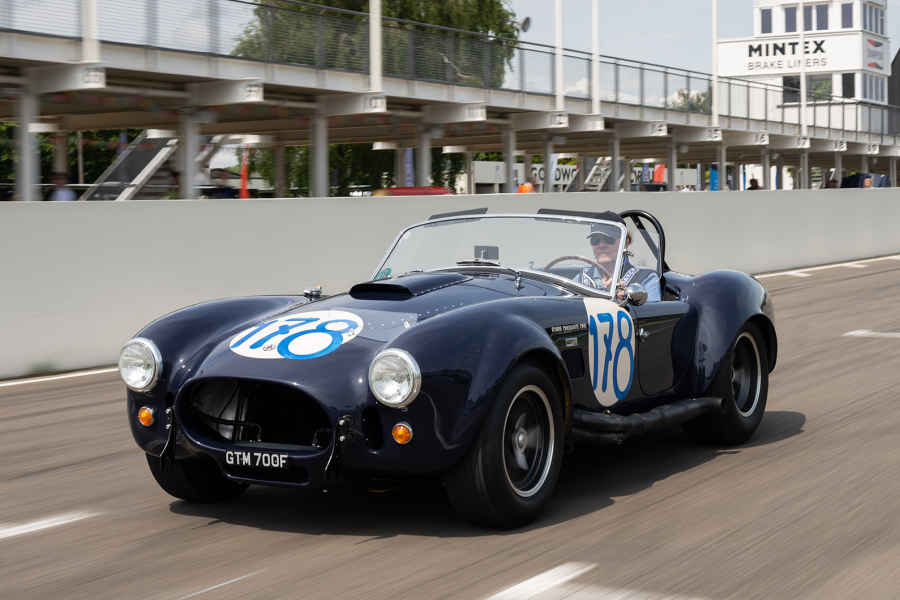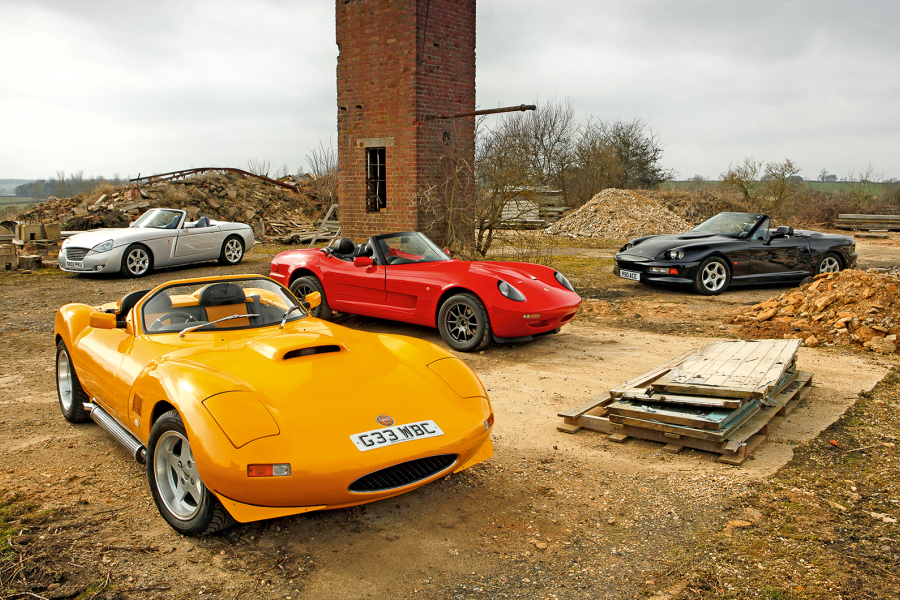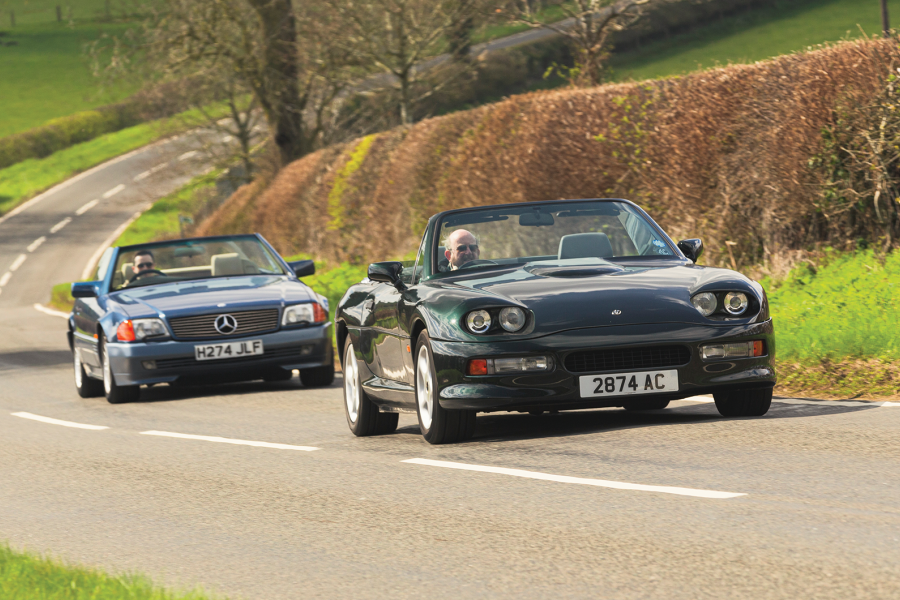One further car (CFX18) was transformed into an Aceca ‘special’ out of a wrecked 428.
The uninitiated might take these cars to be Maseratis and it’s true that the basic shape was heavily influenced by Frua’s Mistral, though they shared only doorhandles and quarterlights.
The fuel-filler hatch blends into the C-pillar
The Mistral is a pretty car, yet the 428 has a bullish machismo of its own (enhanced on Dawn’s cars by subtly wider Borrani wires) like a muscle-bound athlete in a close-fitting suit.
At the front, the V8 is crammed into the engine bay and you can see how it might have struggled to get airflow, although Dawn says that neither car has overheating issues.
At the rear, both variants have deep, square boots, twin tanks and twin fillers. Brimmed to 18 gallons, they made the 428s quite decisively tail-heavy.
The hood on the Convertible is easy to lower and, with no particular sill to negotiate – the chassis tubes are well inboard – getting into either car is easy.
The ’69 Convertible has the prettier fascia, with eight chrome-bezelled instruments in a handsome binnacle and a rash of ‘Guinness bottle’ toggle switches on the centre console.
The late Fastback has the post-1970 Federal dash with a similar instrument arrangement but cheaper-looking rocker switches that feel vague when prodded.
Visibility is excellent and the driving position can accommodate all sizes
Hurlock was very tall so the driving position takes all sizes, the only oddities being the slightly offset pedals and the way that the long gearlever in the manual cants forward.
There’s loads of glass area in the Fastback so views out are wonderful – or they would be if it didn’t mist up so easily in the rain that beset our photoshoot.
Low-slung and long in the bonnet, both have a decadent burble that would bring out the cad in anybody; a lazy sound somehow out of phase with the epic acceleration that is just a caress away.
In 1966, the 428 must have given new meaning to the word ‘effortless’. Manual or automatic gears seem irrelevant in these brawny but docile machines.
In the manual, you can’t push the shift hard or move it fast but, somehow, it goes through smooth and positive every time. Surprisingly, the clutch isn’t particularly hefty.
First is quite long but really this car isn’t fussed which gear you pull away in. Just as AC advertised, it will cheerfully take fourth from 15mph without a shudder, drawn seamlessly away on the silken pulse of eight high-compression pistons.
There is a small luggage shelf behind the seats, but this AC was always strictly for two
In a way, the automatic, with the hooped or inverted horseshoe-shaped selector, is even more impressive, more in the spirit of what the 428 was about.
Squeeze its throttle with any sort of meaning and the coupé just romps away in one great, linear lunge with only minor alterations in engine note to indicate gearchanges.
It’s a feeling of such dominant, fascinating power that I don’t think I would ever get tired of it or immune to it. There is no drama in what could easily have been a hooligan’s car.
Both will chirp their rear wheels but the limited-slip differentials keep everything lined up as the car – automatic or manual – obediently turns torque into horizon-chomping forward thrust.
With a chassis engineered for anti-squat and anti-dive (and running just about the widest tyres you would have found on any car in the late 1960s and early ’70s), both Fastback and Convertible feel totally at ease and entirely stable.
Curves, crests and bends of either the strung-out or bunched-up variety present the flat-cornering, neutral-steering 428 with no difficulties.
The ride is mildly vintage but the Convertible is as free from rattles and scuttle shake as the Fastback. You don’t get much lock for parking, but I didn’t consider the lively unassisted steering unduly weighty in either car.
English ambience meets Italian style and Detroit muscle
The AC 428 was, in some ways, a machine born out of its time.
Drive one and you feel that it is a vehicle more in the raffish 1930s image of a Railton, a Brough Superior or a low-chassis Invicta than the ’60s jet-set machine that its suave Frua styling suggests.
It has muscles and elegance, and is at once a car for both the moustache-twirling bounder and the square-jawed hero.
Once sampled, it leaves an impression that takes days to fade and it might just be my new favourite car.
To date, 61 of the original 81 428s are accounted for and they are seldom parted with. Factoring in the Cobra replicas and the lost-in-action 1970s write-offs, that’s still a handful unaccounted for, so there’s hope yet…
Images: James Mann
Originally published in our February 2017 issue
Factfile
AC 428
- Sold/number built 1966-’73/81 (51 Convertibles, 30 Fastbacks)
- Construction tubular chassis with welded steel body
- Engine all-iron, pushrod, 7014cc 90º Ford V8, four-barrel Holley carburettor; 345bhp @ 4600rpm; 462lb ft @ 2800rpm
- Transmission Ford toploader four-speed manual or C6 three-speed automatic, driving rear wheels via a Salisbury Powr-Lok diff
- Suspension independent all round, by double wishbones, coil springs and Armstrong telescopic dampers
- Steering rack and pinion
- Brakes Girling discs with twin servos
- Wheels and tyres 72-spoke Borrani wires, 205-15 radials
- Length 14ft 8in (4470mm)
- Width 5ft 7in (1702mm)
- Height 4ft 3in (1295mm)
- Wheelbase 8ft (2438mm)
- Weight 3143Ib (1425kg)
- 0-60mph 5.9 secs
- Top speed 145mph
- Quarter-mile 14.2 secs
- Mpg 14-18
- Price new £5573 (’68)
READ MORE
Six of the best: AC Greyhound vs Bristol 406 Zagato
Transatlantic hybrids: Bristol 407, Jensen C-V8 and Gordon-Keeble GK1
The greatest ’50s sports cars: XK120 vs MGA, AC Ace, Healey 100 & TR3A
Open for business: Maserati A6GCS by Frua
Martin Buckley
Senior Contributor, Classic & Sports Car


















